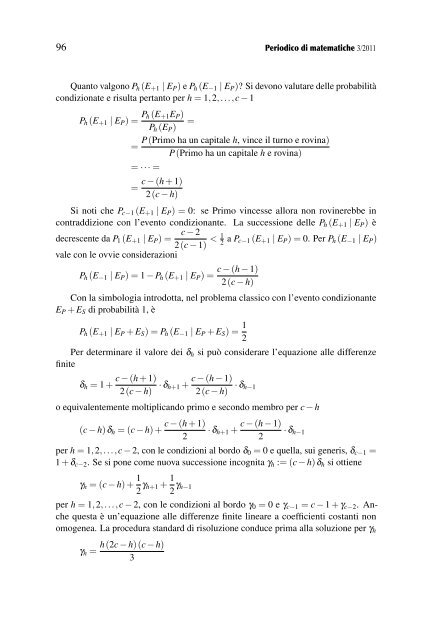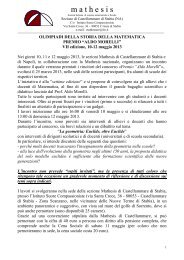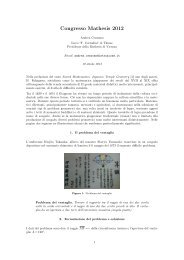Periodico di matematiche - Mathesis
Periodico di matematiche - Mathesis
Periodico di matematiche - Mathesis
You also want an ePaper? Increase the reach of your titles
YUMPU automatically turns print PDFs into web optimized ePapers that Google loves.
96 <strong>Perio<strong>di</strong>co</strong> <strong>di</strong> <strong>matematiche</strong> 3/2011<br />
96 <strong>Perio<strong>di</strong>co</strong> <strong>di</strong> <strong>matematiche</strong> 3/2011<br />
Quanto valgono Ph (E+1 | EP) e Ph (E−1 | EP)? Si devono valutare delle probabilità<br />
con<strong>di</strong>zionate e risulta pertanto per h = 1,2,...,c − 1<br />
Ph (E+1 | EP) = Ph (E+1EP)<br />
Ph (EP) =<br />
= P(Primo ha un capitale h, vince il turno e rovina)<br />
P(Primo ha un capitale h e rovina)<br />
= ··· =<br />
= c − (h + 1)<br />
2(c − h)<br />
Si noti che Pc−1 (E+1 | EP) = 0: se Primo vincesse allora non rovinerebbe in<br />
contrad<strong>di</strong>zione con l’evento con<strong>di</strong>zionante. La successione delle Ph (E+1 | EP) è<br />
c − 2 1<br />
decrescente da P1 (E+1 | EP) = <<br />
2(c − 1) 2 a Pc−1 (E+1 | EP) = 0. Per Ph (E−1 | EP)<br />
vale con le ovvie considerazioni<br />
Ph (E−1 | EP) = 1 − Ph (E+1 | EP) =<br />
c − (h − 1)<br />
2(c − h)<br />
Con la simbologia introdotta, nel problema classico con l’evento con<strong>di</strong>zionante<br />
EP + ES <strong>di</strong> probabilità 1, è<br />
Ph (E+1 | EP + ES) = Ph (E−1 | EP + ES) = 1<br />
2<br />
Per determinare il valore dei δh si può considerare l’equazione alle <strong>di</strong>fferenze<br />
finite<br />
δh = 1 +<br />
c − (h + 1)<br />
2(c − h) · δh+1<br />
c − (h − 1)<br />
+ · δh−1<br />
2(c − h)<br />
o equivalentemente moltiplicando primo e secondo membro per c − h<br />
(c − h)δh = (c − h) +<br />
c − (h + 1)<br />
2<br />
· δh+1 +<br />
c − (h − 1)<br />
2<br />
· δh−1<br />
per h = 1,2,...,c − 2, con le con<strong>di</strong>zioni al bordo δ0 = 0 e quella, sui generis, δc−1 =<br />
1 + δc−2. Se si pone come nuova successione incognita γh := (c − h)δh si ottiene<br />
γh = (c − h) + 1<br />
2 γh+1 + 1<br />
2 γh−1<br />
per h = 1,2,...,c − 2, con le con<strong>di</strong>zioni al bordo γ0 = 0 e γc−1 = c − 1 + γc−2. Anche<br />
questa è un’equazione alle <strong>di</strong>fferenze finite lineare a coefficienti costanti non<br />
omogenea. La procedura standard <strong>di</strong> risoluzione conduce prima alla soluzione per γh<br />
γh =<br />
h(2c − h)(c − h)<br />
3<br />
✐<br />
✐









